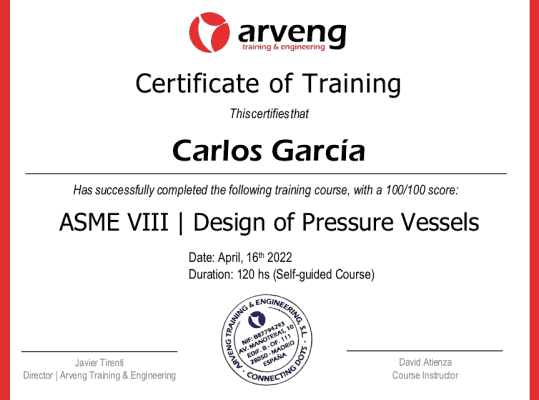IN THIS COURSE YOU WILL LEARN…
+ The vocabulary and principles employed in piping stress analysis.
+ The basic components of a piping system.
+ The basics of strength of materials that are applicable to performing piping stress analysis.
| 364 Students |
| Duration: 40 hours |
| Lectures: Available! |
| Video: English |
| Certificate of Training |
+ The vocabulary and principles employed in piping stress analysis.
+ The basic components of a piping system.
+ The basics of strength of materials that are applicable to performing piping stress analysis.
40 hours of self-guided training through our platform, without scheduled sessions, to progess at your own pace.
40 hours of self-guided training through our platform, with no scheduled sessions, the possibility to ask questions to the instructor, and progress at your own pace.
12 hours of live virtual classes with the instructor. Classes are primarily practical, focusing on the resolution of real-life cases.
Pay for this course in three interest-free installments with PayPal. More information.
This course is available in an in-company modality, tailored exclusively for your organization, adapting dates, schedules and contents to perfectly suit your needs. Reach out to us detailing the training needs of your team, and we will contact you to coordinate it.

This course is intended for graduates (or soon to be), designers, freelancers, technicians and engineers involved in: calculation, design, selection, manufacturing, safety, quality and maintenance of systems and equipment in industrial processes.
Previous knowledge of this subject is not required to attend to the course.
The main objective of this course is to transfer to participants the theoretical and practical skills required in projects, obtained from experience and sound engineering practices.
Get familiar with the ASME B31 Piping Codes, ASME Piping Code Stress Limits, Basics of Flexibility Analysis, Pipe Supports, Basics of Strength of Materials and Loads and Stresses in Piping Systems.
Master the terminology and key concepts of piping stress analysis.
Become familiar with the types of calculations involved in pipe stress analysis.
Course participants will gain the knowledge for design of safe and economical Piping Systems used in industrial applications.
At the end of the course, participants will be able to:
To enroll in this course you have to follow the below steps:
Yes! Contact us indicating your needs and we will find the most convenient alternative for you.
To enroll a 3rd paty/more than one person you have to follow the below steps:
Please, send us your query and we will reply as soon as possible.

Average Rating
Detailed Rating
| Stars 5 |
|
10 |
| Stars 4 |
|
0 |
| Stars 3 |
|
0 |
| Stars 2 |
|
0 |
| Stars 1 |
|
0 |
You must be logged in to post a review.
| 364 Students |
| Duration: 40 hours |
| Lectures: Available! |
| Video: English |
| Certificate of Training |

 WhatsApp
WhatsApp
Chris A.
I really liked the course, and it will be very useful for my work.
Julia R.
The course was very well explained and the material was excellent, it has more than met my expectations.
Karem W.
I am very satisfied with the training received.
Tom S.
I think the structure, content and attention are excellent. Congratulations!
Andrew M.
Very satisfied with the course, precise, concise and clear.
Argyrios L.
It is a very educational course that helped me a lot to understand many things as a new pipe stress analysis engineer. Some real case studies with some calculations and checks from Caesar or Autopipe would probably make it even better, but it is already really helpful.
Ibn I.
The course is very very useful.
Patrick H.
Course was more in depth than I anticipated.
Muhamad
This course is very helpful. I am enjoy to follow this course.
Munthir
The instructor is an expert and the course has met my expectations. 100% recommendable